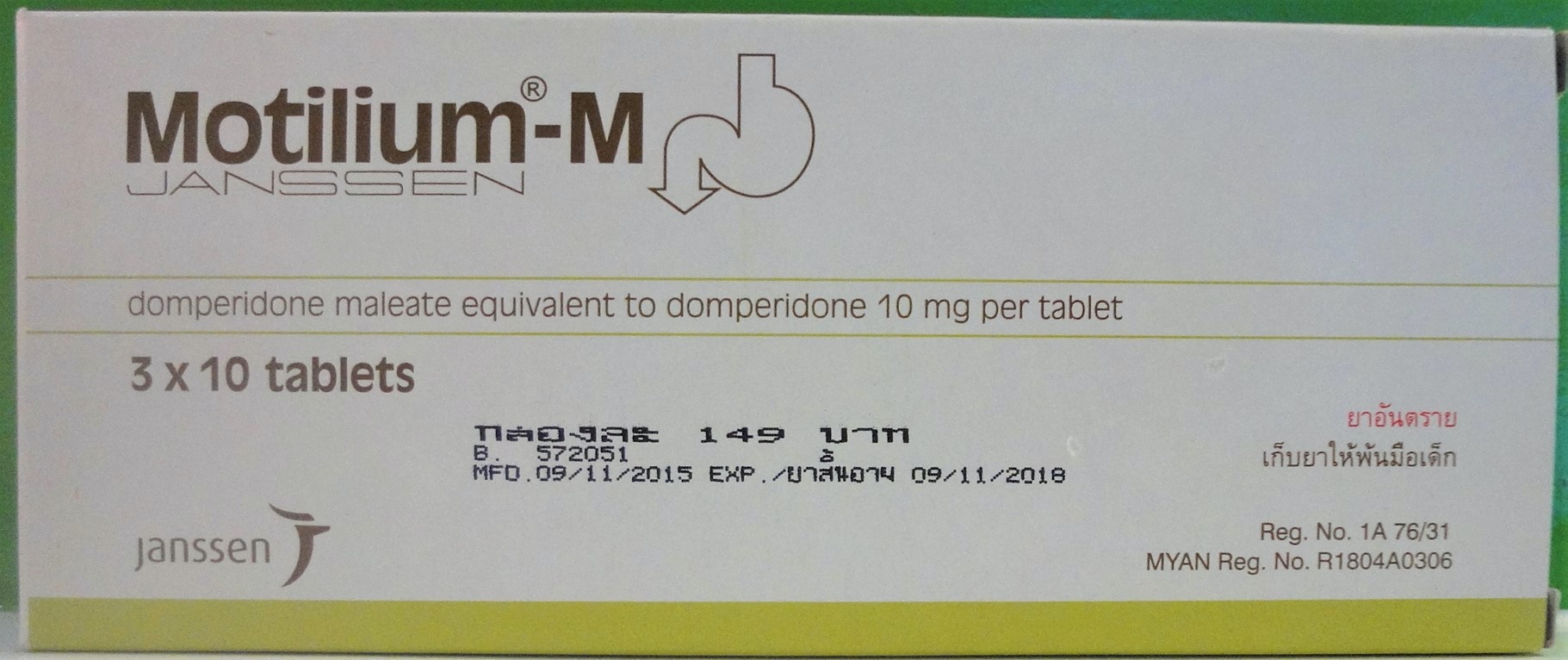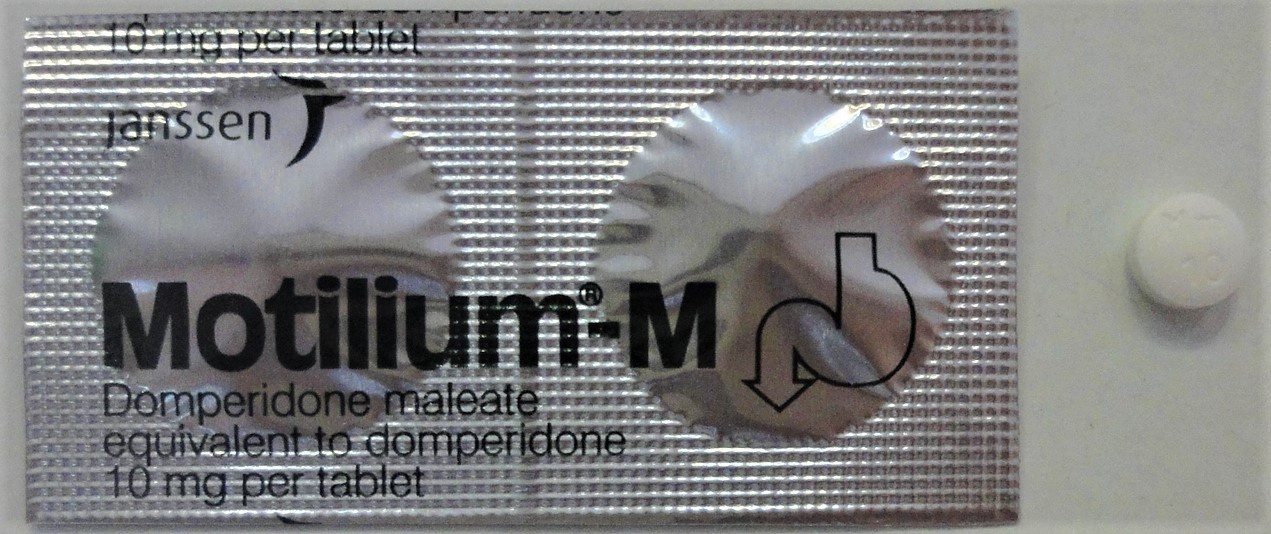MOTILIUM-M Tablet
ក្រុមហ៊ុនផលិតឱសថ:
OLIC (Thailand) Limited, Thailand
ក្រុមហ៊ុនចែកចាយឱសថនៅប្រទេសកម្ពុជា:
DKSH


- សារធាតុសកម្ម
- ប្រសិទ្ធិភាពព្យាបាល និង កម្រិតប្រើប្រាស់
- ហាមប្រើ
- ផលរំខាន
- អន្តរប្រតិកម្ម
- ស្ត្រីមានផ្ទៃពោះ និង ស្ត្រីបំបៅដោះកូន
- ការប្រុងប្រយ័ត្នជាពិសេស បរិយាយប័ណ្ណឱសថ
-
សារធាតុសកម្ម
Domperidone 10mg
-
ប្រសិទ្ធិភាពព្យាបាល និង កម្រិតប្រើប្រាស់
Therapeutic indications:
1. The dyspeptic symptom complex that is often associated with delayed gastric emptying, gastro-oesophageal reflux and oesophagitis,
- epigastric sense of fullness, early satiety, feeling of abdominal distension, upper abdominal pain,
- bloating, eructation, flatulence,
- nausea and vomiting
- heartburn with or without regurgitations of gastric contents in the mouth
2. Nausea and vomiting of functional, organic, infectious or dietary origin.
3. Nausea and vomiting induced by:
- radiotherapy or drug therapy
- dopamine agonists (such as L-dopa and bromocriptine) used in the treatment of Parkinson’s disease.
Posology and Method of Administration:
It is recommended to take oral MOTILIUM-M before meals. If taken after meals, absorption of the drug is somewhat delayed.
Adults and adolescents ≥ 12 years of age and weighing ≥ 35kg
If MOTILIUM-M is not used under medical supervision:
* MOTILIUM-M can be taken a maximum daily dose of 40mg
* Therapy with MOTILIUM-M should not exceed 14 days of continuous treatment without medical consultation.
Infants and children under 12 years old:
Tablets are unsuitable for use in children weighing less than 35kg
Use in renal insufficiency
Since the elimination half-life of domperidone is prolonged in severe renal impairment, on repeated administration the dosing frequency of MOTILIUM-M should be reduced to once or twice daily, depending on the severity of the impairment, and the dose may need to be reduced. Patients on prolonged therapy should be reviewed regularly.
-
ហាមប្រើ
MOTILIUM-M is contraindicated in the following situations:
• Known hypersensitivity to domperidone or any of the excipients.
• Prolactin-releasing pituitary tumour (prolactinoma).
• Co-administration with oral ketoconazole, erythromycin, or other potent CYP3A4 inhibitors which prolong the QTc interval such as fluconazole, voriconazole, clarithromycin, amiodarone, and telithromycin (see 4.5 interaction with other medical products and other forms of interaction).
• Whenever stimulation of gastric motility might be dangerous, e.g. in the presence of gastro-intestinal haemorrhage, mechanical obstruction or perforation.
• In patients with moderate or severe hepatic impairment (see 5.2. Pharmacokinetic properties).
-
ផលរំខាន
+Psychiatric disorders
- Depression
- Anxiety
- Libido Decreased/loss of Libido
+Nervous system disorders
- Headache
- Somnolence
- Akathisia
+Gastrointestinal disorders
- Diarrhoea
+Skin and subcutaneous tissue disorders
- Rash
- Pruritus
+Reproductive system and breast disorders
- Breast Enlargement/Gynaecomastia
- Breast Tenderness
- Galactorrhoea
- Amenorrhoea
- Breast pain
- Menstruation irregular
- Lactation disorder
+General disorders and administration site conditions
- Asthenia
-
អន្តរប្រតិកម្ម
Concomtant administration of anticholinergic drugs may antagonize the anti-dyspeptic effect of MOTILIUM-M.
The main metabolic pathway of domperidone is through CYP3A4. In vitro and human data show that the concomitant use of drugs that significantly inhibit this enzyme may result in increased plasma levels of domperidone.
Examples of potent CYP3A4 inhibitors include:
• Azole antifungals, such as fluconazole*, itraconazole, ketoconazole*, and voriconazole*,
• Macrolide antibiotics, such as clarithromycin* and erythromycin*,
• HIV protease inhibitors, such as amprenavir, atazanavir, fosamprenavir, indinavir, nelfinavir, ritonavir, and saquinavir,
• Calcium antagonists, such as diltiazem and verapamil,
• Amiodarone*
• Aprepitant,
• Nefazodone,
• Telithromycin*
(* also prolong the QTc interval, see Contraindications)
Separate pharmacokinetic/pharmacodynamic interaction studies with oral ketoconazole or oral erythromycin in healthy subjects confirmed a marked inhibition of domperidone’s CYP3A4 mediated first-pass metabolism by these drugs.
With the combination of domperidone 10mg four times daily and ketoconazole 200mg twice daily, a mean QTc prolongation of 9.8 msec, with changes at individual time points ranging from 1.6 to 14.3 msec. Both the Cmax and AUC of domperidone at steady state were increased approximately three-fold in each of these interaction studies see Contraindications.)
The contribution of increased plasma concentrations of domperidone to the observed effect on QTc is not known.
In these studies domperidone monotherapy at 10mg four times daily resulted in increases in mean QTc of 1.6 msec (ketoconazole study) and 2.5 msec (erythromycin study), while ketoconazole monotherapy (200mg twice daily) and erythromycin monotherapy (500mg three times daily) led to increases in mean QTc of 3.8 and 4.9 msec, respectively, over the observation period.
-
ស្ត្រីមានផ្ទៃពោះ និង ស្ត្រីបំបៅដោះកូន
Use during pregnancy:
There are limited post-marketing data on the use of domperidone in pregnant women. A study in rats has shown reproductive toxicity at a high, maternally toxic dose. The potential risk for humans is unknown. Therefore, MOTILIUM-M should only be used during pregnancy when justified by the anticipated therapeutic benefit.
Use during lactation:
The drug is excreted in breast milk of lactation rats (mostly as metabolites: peak concentration of 40 and 800 ng/ml after oral and i.v. administration of 2.5 mg/kg, respectively). Domperidone concentrations in breast milk of lactating women are 10 to 50% of the corresponding plasma concentrations and expected not to exceed 10 ng/ml. The total amount of domperidone excreted in human breast milk is expected to be less than 7 µg per day at the highest recommended dosing regimen. It is not known whether this is harmful to the newborn. Therefore, breast-feeding is not recommended for mothers who are taking MOTILIUM-M.
-
ការប្រុងប្រយ័ត្នជាពិសេស
Cardiac effects
MOTILIUM should be used with caution in older patients or those with current or a history of cardiac disease. Some epidemiological studies have shown domperidone may be associated with an increased risk of serious ventricular arrhythmias or sudden cardiac death (see Side Effects). Those studies suggest this increased risk may be higher in patients older than 60 years of age in patients taking oral doses greater than 30 mg per day.
The film-coated tablets contain lactose and may be unsuitable for patients with lactose intolerance, galactosemia or glucose/galactose malabsorption.
Use in infants
Film-coated tablets are unsuitable for use in children weighing less than 35kg (see 4.2. Posology and Method of administration).
Since metabolic functions and the blood-brain barrier are not fully developed in the first months of life, the risk of neurological side effects is higher in young children (see 4.8. side effects). Therefore, it is recommended that the dose be determined accurately and strictly followed in neonates, infants, toddlers and small children. Overdosing may cause nervous system disorders in children, but other causes should be taken into consideration.
The dose of MOTILIUM-M should be the lowest effective dose for the individual situation (typically 30mg/day) and can be increased if necessary, to a maximum daily oral dose of 80mg (or 120mg for suppositories). The initial duration of treatment is up to four weeks. If treatment exceeds four weeks, patients should be reevaluated and the need for continued treatment reassessed.
*ព័ត៌មានឱសថត្រូវបានរៀបរៀងដោយ អ៊ីម៉ាតុគឹ មេឌីក (ខេមបូឌា) ដោយផ្អែកលើប្រភពព័ត៌មានខាងក្រោម។ សម្រាប់ព័ត៌មានលម្អិត សូមស្វែងរកនៅក្នុងក្រដាសព័ត៌មាននៃឱសថនីមួយៗ ឬ សាកសួរទៅកាន់ក្រុមហ៊ុនឱសថឬតំណាងចែកចាយនៃឱសថនីមួយៗ។
ប្រភពព័ត៌មាន៖
- ក្រដាសព័ត៌មាននៃឱសថសម្រាប់អ្នកជំនាញវេជ្ជសាស្ត្រដែលប្រើប្រាស់នៅប្រទេសជប៉ុន (Pharmaceutical and Medical Devices Agency, Pmda): https://www.pmda.go.jp
- ព័ត៌មានសង្ខេបនៃឱសថសម្រាប់អ្នកជំងឺដែលប្រើប្រាស់នៅប្រទេសជប៉ុន: http://www.rad-ar.or.jp
